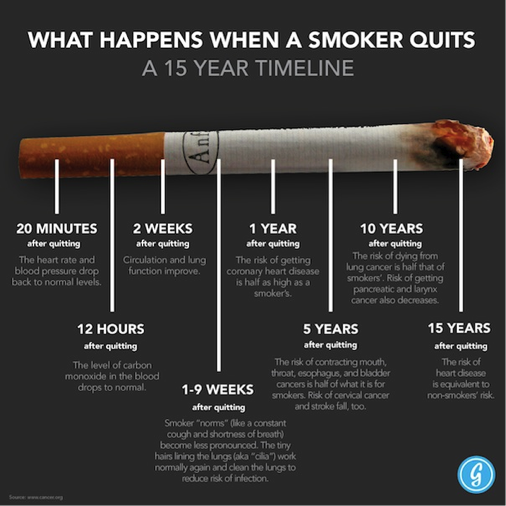Smoking is always considered one of the most dangerous addictions, with several ill effects in the body not just to the smoker but even the person who is next to the smoker, regarded as a passive smoker. There have been several ways given by people on how one can stop / quit smoking but the actual benefits based on the time were not best known by many smokers and non-smokers. As time progresses after the smoking habit is stopped, the health gets better and there are lesser chances of getting cancer by many folds. Smoking increases the risk of a heart disease, but if someone quits smoking, after 15 years the risk of getting a heart attack is same as that of a non-smoker.
Here’s how the changes occur based on the time:
20 Minutes after Quitting the Smoking Habit
During smoking the heart rate and blood pressure are both at higher levels than normal, and once you quit or stop that, 20 minutes after it the heart rate and blood pressure levels drop down to normal.
12 Hours after Quitting the Smoking Habit
Carbon Monoxide levels in the blood falls to normal. After a single cigarette smoked, the carbon monoxide levels are higher than normal for the next 12 hours.
2 Weeks to 3 Months after Quitting the Smoking Habit
The circulation in the body improves, and the lung function increases. Both of these are below the normal levels when the smoking was regularly done, and doesn’t get back to normal just in a few days.
1 to 9 Months after Quitting the Smoking Habit
Smoking is associated with coughing and shortness of breath, but once that habit is gone, the coughing is reduced and the shortness of breath is decreased, while the Cilia (the tiny hair-like projections that move the mucus out of the lungs) regain their normal functioning which was diminished due to the smoke, and while regaining the ability to handle the mucus and push it out. With this, the risk of infection is reduced by many folds.
1 Year after Quitting the Smoking Habit
Coronary heart disease is one of the largest risks for chronic smokers, but once the habit is completely stopped, the risk of the Coronary heart disease is half that of a smoker who is still continuing with the habit.
5 Years after Quitting the Smoking Habit
Smoking can lead to cancers in various parts of the body, which include the mouth, throat, esophagus, bladder and the cervical area. In the time of 5 years after the smoking habit is stopped, the risk of cancer to the mouth, throat, esophagus and bladder decreases by half. The risk of Cervical cancer is the same to that of a non-smoker.
In 2-5 years after the person quits smoking, the risk of stroke reduces to that of a non-smoker.
10 Years after Quitting the Smoking Habit
Several lung cancers can lead to death, but after the habit is quit completely, the normal life of 10 years would reduce the risk of death due to lung cancer to half of that in the smokers. The risk of cancer in the Larynx and Pancreas decreases.
15 Years after Quitting the Smoking Habit
The risk of Coronary Heart Disease is same as that in the non-smokers.
Now, let’s see what all does the habit quitting help in –
- Lowering the risk of Diabetes
- Blood vessels functioning increases
- The oral tissues come back to normal after a certain time and healthy diet
It again depends on the age of the person who is quitting. If you are very young and quitting the habit already, it would reduce the risks at a higher rate, while in older age people it would take more time for the risks to go down, but be that any age, quit and you will start feeling better. If you have started quitting, but still crave for tobacco, here’s how you can resist tobacco craving.

Its also good to know that smoking in the first 30-40 minutes of waking up can rise the risks of cancer with 50-60%. Its better to have some breakfeast first and outwait that much needed nicotine in the morning.